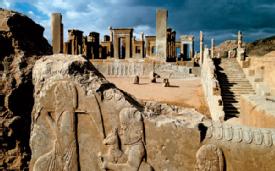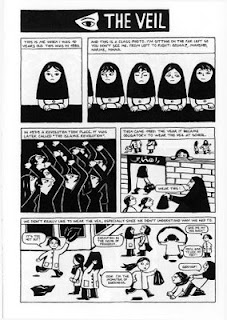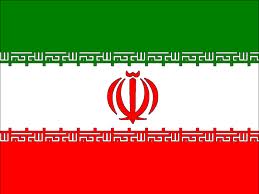Historical Context
Historical Contextualisation of Persepolis
The title of Persepolis relates to the ancient capital city of the Persian Empire, which now lies in ruins, and this title acts as a reminder of the turbulent history that Iran has faced. It awakens the idea that colonisation and the destruction of the past is not a concept that is limited to the West, but has been experienced all over the world. In the Western capitalist exploitation of the East there is a move towards the destruction of the ancient world and history. The city of Persepolis as the title of the book alludes to the action of modernity through capitalism in wiping out the past.
When Text was Written and Historical Conditions of the Author and her World
Persepolis was written between 2000 and 2004 in France and was initially published in French. This is significant due to Marjane Satrapi’s emphasis on being taught French as a young girl, which is documented within the text. This significance is also heightened against the backdrop of growing up in turbulent Iran. ‘If there was to be a future, in my parent’s eyes, that future was linked to my French education’ (Satrapi 137). After her unsettled teenage years and return to Iran, Satrapi has lived in Europe since 1994. Satrapi’s upbringing allowed her to experience other cultures, spending her first 14 years in her native Iran before her parents sent her to Vienna, Austria, enabling her to continue her French education and removing her from the unsettled situation in Iran. Satrapi returned to her native homeland after finishing her high school career, however she then returned to Europe in 1994. In Persepolis, she is able to reveal the universal parallels of growing up, irrespective of one’s culture or the culture that one finds oneself in. Her journey shows that not everything is dependent on where one comes from or what nationality one is. On the other hand, Satrapi clearly portrays the importance of remembering where one has come from, of heritage, history and integrity. From her multicultural upbringing Satrapi’s reveals a world that is able to encompass both the East and the West, she bridges the gap and shows in black and white how mutual understanding can be reached.
When the Text was set and Historical Conditions
Persepolis spans eighteen years of Satrapi’s life from the ages of six to twenty four, detailing 1976 to 1994. However, it embraces and recounts Iranian history from the last 2,500 years. Therefore, it enables an understanding to be reached of the past that Iran has faced and awakens an understanding of their resistance to economic colonisation from the West.
Page 11 reveals how Iran has been under constant attack and threat and how the people of Iran have never had their voices heard; that they have always been forced into submission by ‘tyranny’ (Satrapi 11). ‘First our own Emperors. Then the Arab invasion from the West. Followed by the Mongolian invasion from the East. And finally Modern Imperialism.’ (Satrapi, 11).
Satrapi’s depiction of the involvement of the West, namely Britain, in the construction of the Iran of today reveals the lack of understanding that Britain has of these countries that it later deems as a terrorist nation. This manipulation shown by the British is amplified in the exploitation of Iran’s oil, without any consideration for the people of the nation. ‘You just give us the oil and we’ll take care of the rest.’ (Satrapi, 21). This then can emphasise  how the West can dictate its own politics and dominance over the East for their own gain.
how the West can dictate its own politics and dominance over the East for their own gain.
After what seemed a positive step in terms of national identity and liberation in the form of revolution, the Iranians were then forced under a strict code of conduct into a regimented way of life. 1980 saw a nation purging Capitalism from every street and every household. ‘All Bilingual schools must be closed down. They are symbols of Capitalism’ (Satrapi 4). This was known as the Cultural Revolution.
In 1980, Iraq sees Iran in a vulnerable state, and seizes upon an opportunity to regain previously lost territory and replace Iran as the most prominent or significant Middle East nation.
The Veil
Within Persepolis, Statrapi often mentions the contention surrounding the veil, or specifically within Iran, the hijab. Within Islam the veil is believed to be an important part of religious practice, and also serves a practical purpose in keeping women ‘modest’ in public view of men who are not their husbands.
This originally stemmed from the guidance found within the Quran:
‘And say that the believing women that they should lower their gaze and guard their modesty that they should not display their beauty and ornaments except what (must ordinarily) appear thereof; that they should draw their veils over their bosoms and not display their beauty except to their husbands, their fathers, their husband's fathers, their sons, their husbands' sons, their brothers or their brothers' sons, or their sisters' sons, or their women, or the slaves whom their right hands possess, or male servants free of physical needs, or small children who have no sense of the shame of sex; and that they should not strike their feet in order to draw attention to their hidden ornaments. And O ye Believers! turn ye all together towards Allah, that ye may attain Bliss.’(Quran 24:31)
Many Muslims uphold this view, and use the veil in order to maintain this ‘modesty’.
In Persepolis however, it is clear that Satrapi and her family are against the use of the veil. Whilst living in Europe, for example, Marjane does not wear a veil at all. Both Section 1 of the first part and Section 9 of the second of Persepolis are significantly entitled, ‘The Veil’. Section 9 details Satrapi’s realisation of needing to return to Iran after months of unhappiness and poverty. It ends an image of Satrapi putting her veil back on after years without it, accompanied by the caption ‘I packed my bag…I again put on my veil… and so much for my individual and social liberties… I needed so badly to go home.’ (247)
The history of the veil is important to its modern understanding. In the current political state it is religious law to where a veil in Iran. Many women, especially youngsters, have taken to wearing transparent, colourful and very loosely worn Hijabs to protest against the laws but keep within the rules of the state. It is widely recognised that this is not the case in other countries worldwide, as in France and Turkey for example, the veil or hijab is banned in schools nationwide.
Originally, the Veil predates the Islamic religion, and only started to become common with Muslim women in the second Islamic century. Also, it was mainly worn by the powerful and rich as a status symbol and not by rural working women. The veil, in these days, was only worn to show that a household had the means and the money to wear such things; to denote wealth and authority. This meant that the vast majority of women could freely go into town without veiling.
The veil became common rule around the tenth century, as during the Middle Ages many laws were developed that put women at a greater disadvantage, and the veil was part of these new regulations. The nineteenth century, however, brought about a new wave of liberal thinking, which was directed originally from western thought, that the veil produced exclusion for women within society and public life. Over the early parts of the twentieth century, the veil was continually questioned, with many intellectuals believing that women should be able to have the choice themselves and that men should learn to be able to not harass unveiled women.
(Nicholas Kristof ‘Historical Perspectives on Islamic Dress’ WomenInWorldHistory.com)
As the West increasingly encroaches on the Iran through the spread of modernity in globalised capitalism, it pushed the Iranian government to adopt ever more fundamentalist attitudes in reaction and response to the West’s infiltration of their country and lifestyle. Hence, anyone who does not ware the veil or adheres to the fundamentalist laws are considered to be capitalist and therefore Western.
Persepolis Timeline of Historical Events
The historical events that are alluded to in Persepolis through Satrapi’s childlike eyes are presented in this timeline, by the free library. This places them in their historical context, therefore allowing a more complete understanding of the events and causes which are depicted in Persepolis.
http://libwww.freelibrary.org/onebook/obop10/Persepolis_timeline.pdf
When the Text is being Read and Historical Context of that Time
Persepolis was initially published at the beginning of the millennium, before the West introduced military intervention in the Middle East, staring with Iraq in 2003. The two halves of Persepolis were published together in 2008. This therefore presents Persepolis as an incredibly current and relevant novel, especially as the West continues to demonstrate political and moral dominance in parts of the Middle East and Northern Africa. The novel’s innocent depiction of Satrapi’s universal coming-of-age aligns a personal factor to the news stories and awakens a concern for the reality of what is occurring within these war zones. Satrapi in writing the history of her nation in a way that a child would write and understand it, allows for sympathy and understanding to be awakened in the readers as they look into what occurred.
These events, which are also documented in the timeline, highlight the historical context of the time in which Persepolis is being read, therefore enhancing the understanding of the importance in this graphic novel in creating a human side to the wars that the West are fighting.
http://libwww.freelibrary.org/onebook/obop10/Persepolis_timeline.pdf
Relationship Between When it was Written and When it was Read
The years in which Persepolis was written preceded a decade of military intervention in the East. Therefore this graphic novel, although dealing with the events of the past, throws considerable light onto the current events and events of the future. Persepolis is not an historical text book with the facts and the figures of the events of the last century in Iran, however it presents a personal view and interpretation of the events that occurred. Therefore, it calls into question the events of the present and the effect that these events are having on the Iranian people. These events which are often driven by capitalist economic gain and security. As Anup Shah states that ‘Given the vast energy resources [oil] that form the backbone of western economies, influence and involvement in the Middle East has been of paramount importance for the former and current imperial and super powers, including France, Britain, USA and the former Soviet Union.’ (http://www.globalissues.org/issue/103/middle-east 11 May 2012). As Persepolis depicts the suffering that occurred in response to the revolts and the Islamic Revolution (Satrapi 14-15, 38-39), a long term cause of which was the interference of the British , who in desiring to attain the oil for themselves displaced the whole of the Iranian political system. However, instead of the West reaching an understanding where it is their exploitation of the Middle East that has caused these turbulent problems, ‘western populations have been acclimatized to a type of propaganda and vilification of the Arab and other people of the Middle East, and of Islam in general’ (http://www.globalissues.org/issue/103/middle-east 11 May 2012). Hence one of the effects of Persepolis is highlighting in childlike simplistic terms the effect that the West has had on the Middle East. Persepolis is a novel for our time and can be seen as raising the questions of whether the destruction and death that is caused can justify the capitalistic gain. The problems and questions raised in this graphic novel are extremely relevant to our society today. In a society that is ready to establish the categories of us and them, but not able to acknowledge the part that it historically had to play in the creating of the ‘them’.
, who in desiring to attain the oil for themselves displaced the whole of the Iranian political system. However, instead of the West reaching an understanding where it is their exploitation of the Middle East that has caused these turbulent problems, ‘western populations have been acclimatized to a type of propaganda and vilification of the Arab and other people of the Middle East, and of Islam in general’ (http://www.globalissues.org/issue/103/middle-east 11 May 2012). Hence one of the effects of Persepolis is highlighting in childlike simplistic terms the effect that the West has had on the Middle East. Persepolis is a novel for our time and can be seen as raising the questions of whether the destruction and death that is caused can justify the capitalistic gain. The problems and questions raised in this graphic novel are extremely relevant to our society today. In a society that is ready to establish the categories of us and them, but not able to acknowledge the part that it historically had to play in the creating of the ‘them’.
By Eimhin Walker and Luke Maundrell
